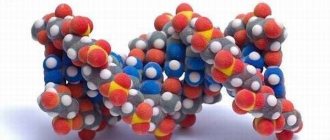What are tumor markers and their normal values?
A blood test for tumor markers is prescribed to patients who are at risk (hereditary predisposition, complicated medical history) and also when pathological signs are identified that may indicate the occurrence of an oncological process in the body.
Particular attention should be paid to results that exceed the norms. What could this indicate?
Using a blood test for tumor markers in women, you can determine:
- The presence of a malignant tumor. In this case, it is necessary to confirm the diagnosis with other diagnostic methods;
- Localization of the pathological process, since different protein compounds are produced when certain tissues and organs are damaged;
- It is important that the collected blood is delivered to the laboratory for testing no later than 1.5 hours after its collection, and the tube must be stored in a special box where the temperature is maintained no higher than 8°C.
- The effectiveness of treatment in women with cancer. In this case, a comparative analysis of the results before treatment, during and after the end of the course of therapy is carried out;
- The condition of cancer patients after surgical treatment;
- Possibility of relapse (a gradual increase in the concentration of these markers is observed).
It should be noted that analysis of tumor markers helps to distinguish benign tumors from malignant ones.
Quite often, patients have suspicions about the reliability of this study. It is worth noting that there are about 200 types of tumor markers, but no more than 20 have diagnostic value in relation to oncological processes.
It should be borne in mind that an increase in the concentration of tumor markers in the blood does not always indicate the presence of cancer. In this case, suspicions are supported by the results of a number of examinations.
In some cases, an increase in the number of tumor markers (decrease in reliability) is associated with the physiological characteristics of the female body, as well as the presence of other diseases.
Factors influencing the reliability of the analysis results:
- The period of menstruation and a few days before its onset;
- Pregnancy;
- Stressful state;
- Hormonal imbalance;
- Benign tumors of the female genital organs;
- Large cysts;
- Inflammation occurring in acute or chronic form.
It should be noted that it is advisable to study tumor markers in a certain combination (determine the concentration of several indicators at once). This will increase the reliability of the result obtained.
Please note that it is possible to obtain a false result. It can be both positive and negative.
In order for the result of a study on the level of tumor markers to be reliable, it is necessary:
- Properly prepare for the study (blood is donated in the morning on an empty stomach, and you should also not drink tea, coffee, juices and carbonated water; you should not drink alcohol the day before; do not smoke before the study);
- Avoid laboratory mistakes, that is, use proper equipment, carry out calculations correctly, and so on;
- Consider the period of the menstrual cycle.
If all of the above factors are taken into account, the results of the analysis will be correct.
Women often develop cancer of the reproductive, digestive and respiratory systems. Moreover, the increase in the number of tumor markers in the blood begins before the symptoms of the disease appear. It should be taken into account that a specific marker indicates the development of a particular tumor, as well as some non-specific (non-oncological) pathological processes.
SCC is a squamous cell carcinoma antigen. This marker is a laboratory sign of the presence of a malignant tumor, which tends to grow invasively (the tumor grows into the tissue, metastases occur in the surrounding organs).
The normal SCC tumor marker for women is considered to be no more than 2.5 ng/ml.
An increase in SCC concentration is observed in the following cases:
- Squamous cell carcinoma of the cervix, vagina and external genitalia;
- Squamous cell cancer of the digestive organs (oral cavity, esophagus, intestines, etc.);
- Squamous cell carcinoma of the lung;
- Chronic pathology of the lungs and bronchi;
- Inflammation of liver tissue (cirrhosis);
- ARVI (it is recommended to take the test at least 14 days after the infection);
- Pancreatitis – inflammation of the pancreas;
- Endometriosis;
- Skin diseases (eczema, pemphigus, psoriasis).
AFP and hCG
HCG is human chorionic gonadotropin. ACE – alpha-fetoprotein (indicator of primary liver cancer). Normally, they are present in large quantities in pregnant women. They ensure the normal course of pregnancy.
In non-pregnant women, markers of AFP and hCG are also present, but in small quantities: AFP - less than 15 IU/ml and hCG - less than 5 IU/ml.
Reasons for increasing hCG values:
- Malignant neoplasms of the ovaries;
- Cancer of the digestive organs (stomach and esophagus);
- Lungs' cancer.
A decrease in hCG concentration is a dangerous sign for a pregnant woman. This occurs when there is a high risk of miscarriage.
Reasons for increasing AFP concentration:
- Cancer of the digestive organs (stomach, liver, pancreas, colon);
- Ovarian teratoblastoma;
- Malignant lung tumors;
- Non-oncological liver diseases (hepatitis and cirrhosis).
SA 15-3
CA 15-3 is an indicator of the presence of tumor formations in the tissues of the mammary glands. The normal level of tumor marker CA 15-3 in the blood of women should be no more than 22 IU/ml. Its values increase long before the first symptoms of the disease appear, which is an important diagnostic sign. This ensures early detection of pathology and a favorable prognosis.
Reasons for increasing values of tumor marker CA 15-3:
- Malignant tumor of the mammary glands;
- Cancer of the reproductive system (ovaries, cervix, endometrium, uterus);
- Oncological process in the digestive organs (stomach, pancreas, liver);
- Lung cancer (with a significant increase in concentration).
SA 72-4
Marker CA 72-4 is a sign of malignant neoplasm of the stomach, as well as the ovaries and respiratory organs.
If the CA 72-4 tumor marker exceeds 3 IU/ml, then this indicates the presence of stomach cancer with 100% probability.
Determination of the marker is necessary for early detection of pathology, monitoring and evaluation of treatment effectiveness. Its indicators increase in both oncological and non-oncological pathologies.
Reasons for increasing the CA 72-4 indicator:
- Cancer of the digestive organs (stomach, pancreas, colon);
- Oncology of the genital organs (ovaries, endometrium);
- Malignant neoplasms of the mammary glands and lungs;
- Diseases of the internal genital organs;
- Inflammation of the liver and so on.
CA 125
CA 125 is a glycoprotein that indicates the presence of ovarian cancer. The normal limits for this marker are from 15 to 35 units/ml. This tumor marker is usually assessed in conjunction with other indicators (for example, he 4 marker).
CA 125 helps to identify pathology, the spread of metastases and evaluate the result of treatment.
Reasons for increased concentration of CA 125:
- Cancer of the ovaries, uterus and endometrium (most often, increases are detected in women with these pathologies);
- Malignant tumor of the breast;
- Oncological process of the digestive and respiratory organs.
A slight increase is observed in the presence of inflammatory gynecological diseases, as well as pathologies of the respiratory system and gastrointestinal tract.
Carcinoembryonic antigen (CEA) is normally practically absent in the body of a healthy person. These values should not exceed 5 ng/ml. It should be noted that a slight deviation from the norm may be observed in a woman during pregnancy. This indicator is not considered a sign of pathology, since CEA is produced by the cells of the fetal digestive tract. In all other cases, this indicates the presence of diseases.
Reasons for the sharp increase in RAE:
- Malignant neoplasms of the gastrointestinal tract: stomach, pancreas, large intestine and rectum;
- Metastasis to the liver;
- Lung and breast cancer;
- Oncological pathology of the ovaries.
A moderate increase in the concentration of RAE marker in the blood can be caused by inflammatory diseases of the digestive system, as well as tuberculosis.
The HE 4 marker is specific for ovarian cancer. It is the most informative, unlike CA 125. Normally, this marker is present in the body of women and men, since it is produced in small quantities by the cells of the endometrium, respiratory organs and fallopian tubes.
We suggest that you familiarize yourself with Fluconazole for the prevention of thrush in women
Normal limits for tumor marker HE 4:
- In women of reproductive age (up to 40 years), the level should not exceed 59 pmol/l;
- In women over 40 (when premenopause occurs), the normal value is slightly increased, but it should not exceed 100 pmol/l.
The indicator increases in the blood long before the onset of pathological symptoms, which allows for timely treatment and increases the chances of recovery.
It should be taken into account that he 4 is sensitive only to the squamous form of cancer. That is, if a woman has another type of this pathology, then the tumor marker indicators will remain within normal limits.
In gynecology and oncology, if a malignant neoplasm of the genital organs is suspected, an analysis for a combination of CA 125 and he 4 markers is indicated.
Reasons for the increase in he 4 tumor marker:
- Squamous cell carcinoma of the ovaries;
- Ovarian cyst;
- Endometriosis;
- Myoma (benign tumor);
- Pathology of the liver and kidneys.
SA 27-29
Tumor marker CA 27-29 is used for suspected breast cancer. The normal level of this substance in the blood of healthy women is no more than 38 U/ml.
It should be noted that the connection between a malignant breast tumor and an increase in this indicator is not always determined. Therefore, a blood test for CA 27-29 is carried out in conjunction with other studies. The diagnosis is made based on the results of all diagnostic methods, and not just a positive blood test.
A decrease in the concentration of CA 27-29 during adequate treatment indicates regression of the pathological process. If the concentration increases or remains at the same level, this indicates that the tumor is immune to the drugs.
The CA 27-29 marker is more often used to monitor breast cancer treatment or for early detection of cancer recurrence.
Other markers
- Gynecological cancer kills millions of women every year.
- The first symptoms of the disease appear quite early, but women either do not pay attention to them or are embarrassed to see a doctor.
- Female tumor markers make it possible to diagnose oncopathology of the female genital organs without additional research methods.
What is a tumor marker
First of all, let’s find out the answer to the most important question: what is a tumor marker?
Oncological markers are rather specific materials of protein origin that appear in the blood or urine of people if they have cancer. These substances are quite diverse, but mostly they are a protein substance or its analogues. There are two types of oncological markers - very specific (appear in any specific malignant formations) and less specific - react to many types of cancer. A malignant tumor cell uniquely releases 1 pictogram of a tumor marker into the blood of one milligram of antigen, which in the form of a concentration looks like 200 ng/ml. Innovative technologies in diagnostic laboratories make it possible to determine the excess of markers even in minor tumors, that is, in the initial stages of cancer.
Tumor markers for women - the decoding of the phrase sounds like this: tests that provide a chance to detect cancer and prevent spread by killing malignant cells in the first stages.
Important! To properly detect the underlying cancer, it is recommended to visit a gynecologist twice a year.
Next, you need to find out the types: what are the tumor markers for women?
Regardless of age, the body of any woman produces hormonal substances in significantly larger quantities than normal in case of cancer of the reproductive system. In order to dispel doubts about the disease, doctors prescribe various markers.
https://youtu.be/e_qv8qz_tDo
What tumor markers are typical for the fair sex?
- CA 125 - in the initial screening of ovarian cancer, this marker is used in combination with ultrasound, biopsy and x-ray. Doctors can determine oncology based on the results below:
- 35 ng/ml for postmenopausal females;
- 200 ng/ml for patients in the premenopausal period.
For oncology research, CA 125 is used primarily for quality control of anti-cancer therapy for women with the determination of ovarian cancer. If these indicators do not change, this may indicate ineffective treatment or re-appearance of the tumor.
- REA marker. The normal level of this material is 0-5 ng/ml. Oncological embryonic antigen is produced by cells of the embryonic gastrointestinal tract. Naturally, during pregnancy, an increase in this protein is normal. In other situations, the CEA tumor marker indicates malignant tumors of the digestive system and breast cancer.
- Alpha fetoprotein. It is the blood serum of an embryo. Its maximum accumulation occurs in the twelfth week and reaches 3 mg/ml. The content of AF protein decreases greatly after the baby is born. An adult should have no more than 10 ng/ml AFP. This protein is a component of the cytoplasm of ovarian tumor cells. In women with cancer, a significant percentage of AFP is a pretext for making an accurate conclusion. Also, a level of 10,000 ng/ml indicates the need for urgent intensive oncological treatment.
- Estradiol. The antigen has a simple communication system and is used to monitor the woman’s reproductive system in the postoperative period.
- Carcinoembryonic antigen. In almost all cases, patients with vaginal adenosis experience an increase in the accumulation of CEA.
- Squamous cell carcinoma antigen. Indicates inflammation of the cervix and good-quality epithelial tumors. This antigen helps specialists determine the effectiveness of chemical therapy and the likelihood of relapse.
- Antigen 19-9. A special substance of the female genital system. According to statistics, an increase in the content of this substance is 36% associated with endometrial cancer. The productivity of antigen 19-9 research provides a chance to primarily identify the return of the disease.
- Cancer antigen 27-29. A high level of marker in the blood is a sign of cancer of the rectum, stomach, liver or ovaries.
- Telomerase. In hospital activities, the increase in the density of this marker depends on the tumor marker CA 125. The overall result of such markers adds to the accuracy of oncological examination.
- Topoisomerase. Indicates the outcome of recovery from ovarian cancer.
What you need to know before the procedure
Before carrying out the analysis, you must be aware of the recommendations of doctors and contraindications to it. Below are some of the most important steps you should avoid to ensure your test results are accurate. Preparation for analysis is as follows:
- It is not recommended to donate blood during the menstrual cycle in women or during inflammatory processes. Changes affecting hormones can distort the results obtained.
- Three days before blood sampling, you should not drink alcoholic beverages. Ethanol quickly penetrates the blood, changing its composition. This will compromise the accuracy of the test results, producing an elevated antigen reading.
- The examination must be carried out in the first half of the day. At this time, the level of antigen concentration is high, so the test performance increases.
- It is recommended to donate blood on an empty stomach, when processes associated with digesting food are not occurring in the body. The blood does not contain impurities or additional substances and is normal. In the morning you are allowed to drink several glasses of water. This will muffle the feeling of hunger, and a feeling of fullness will appear in the stomach.
- Two to three days before the procedure, you should carefully review your diet. Excessive amounts of protein foods will skew the results. It is also important to minimize the consumption of fatty and smoked foods seasoned with a lot of spices.
- You should stop smoking and drinking alcohol. This will affect the accuracy of the indicators.
- Exhaustive physical activity is strongly not recommended during the examination period. It is better to avoid visiting sports complexes, fitness clubs, and playing sports during the test. This will have a beneficial effect on the accuracy of the study.
- Taking medications distorts the examination results. Therefore, it is recommended to stop taking medications three days before blood collection. If stopping medications is not possible, then you should inform your doctor about this.
- If the procedure is performed on a child, it is advised to drink water for half an hour to replenish the volume of fluid in the body.
The results of the analysis are prepared within ten days, depending on the clinic and the complexity of the disease. If a repeat procedure is required, the attending physician will inform the patient. Tumor marker testing is carried out monthly to exclude relapse after therapy, as well as to study the effectiveness and efficiency of the chosen treatment.
Five years after the course of therapy, examinations are carried out once a year. You should donate blood for protein pigment regularly in case of metastases. If high levels are detected, doctors perform a repeat analysis. The diagnosis is not established after a single blood draw. If there are signals of pathology, a comprehensive examination is carried out in order to identify the true cause.
What is achieved during the examination
Blood contains protein antigens. They are found in moderation in every healthy body. But when a benign or malignant tumor forms, the indicators exceed the permissible norm. The amount of specific proteins also increases when pathologies of the kidneys, liver, stomach or genitourinary system occur. A specially developed table of indicators, given below in the article, allows you to determine the nature of the disease in cancer.
If negative indicators are detected, additional examinations are prescribed. Thus, the malignant type of formation and pathologies of internal organs are diagnosed in the early stages, which are eliminated thanks to timely treatment. In advanced stages of the disease, when cure is impossible, complete remission and elimination of pain symptoms are achieved.
What tumor markers should a woman take?
For the prevention and detection of diseases, only specific indicators are used that can make it possible to identify oncology. You need to know that all tumor markers are extremely sensitive to any inflammatory processes. Therefore, if at least one source of infection is present in the body, tests can show the presence of cancer cells. For the result to be correct, it is initially necessary to undergo an inpatient examination and completely exclude chronic ailments.
View gallery
Main tumor markers:
- “CA-15–3 and MSA” are intended to detect malignant tumors in the breast. Also, using these indicators, the absence or presence of metastases is determined.
- Decoding the tumor marker “CA-125” shows the presence or absence of ovarian cancer. Also, this protein structure occurs in increased quantities during pregnancy. Therefore, if “CA-125” is positive, then additional examinations are carried out.
- “CA-72–4” - this type is used in cases where there is a suspicion of ovarian cancer, when you need to be completely sure that the treatment is being carried out correctly, and also to confirm the gradual destruction of malignant cells.
- HCG in women helps diagnose uterine cancer. Thanks to the test, pathological abnormalities can be identified at an early stage. In addition, such an analysis is used to re-diagnose the disease in uterine tissue after surgery.
Functions in the body
All types of cancerous tumors release special protein substances into the blood. It is by such substances that one can judge the presence of malignant tumors in the body. These protein substances are called tumor markers. Tumor markers are also present in the urine.
In addition to early diagnosis of cancer, tumor markers also perform other tasks:
- Monitor the course of the disease.
- The effectiveness of the therapy is monitored.
- Prevents the progression of metastases to other organs.
More than 150 substances are known that, in their properties, belong to tumor markers. But 30 of them are suitable for examination. Only this amount has high specificity; their level becomes higher with cancer of different localizations.
In medicine, the following types are distinguished:
- SA-125. The glycoprotein is high molecular weight, it is formed by cancer cells that appear in the ovary. Its high level diagnoses a malignant tumor of the pancreas.
- SA-15-3. A specific marker that is located in the area of malignancy, but is produced by ovarian cells and the pancreas.
- HE4. The content of this tumor marker becomes higher in tumors formed in the female genital organs.
- SCC. It is involved in the differentiation of squamous epithelium and is produced by the salivary glands. Analysis for this tumor marker is prescribed to monitor the course of the disease.
- AFP. This protein is found in the body of pregnant women and is considered normal. In other cases, it increases with liver cancer.
- REA. It is formed during the process of bearing a child by fetal cells. At high levels, cancer of the uterus, prostate, and lungs can form.
- CA 19-9. Tumor marker of the gastrointestinal tract system (gastrointestinal cancer, prostate cancer).
- B-2-MG. A high tumor marker may occur in autoimmune diseases, myeloma and leukemia.
Tumor marker monitoring
Monitoring the dynamics of tumor markers plays an important role in cancer therapy. This allows you to determine the effectiveness of treatment and timely adjust its regimen. For example, during chemotherapy and radiation therapy, it is possible to increase the level of markers, which does not indicate an exacerbation of the process, but rather lysis of the tumor. Together with other indicators, biomarkers make it possible to monitor the patient’s health status during therapy and at its end.
You can get tested for tumor markers at the Medical Genetics Center.
How and under what conditions is it produced?
A blood test for tumor markers in women is needed to identify pathology. But besides them, there are markers of hepatitis and pancreatitis. All results and values in the laboratory are tumor markers of some disease.
We suggest you familiarize yourself with endometrial polyp when to do an ultrasound
Moreover, in order to attribute the results to a tumor marker of any disease, it is necessary that its amount in the body changes with a specific pathology. To classify an indicator as a tumor marker of liver disease, it is necessary that the amount of protein substances becomes less or more precisely in case of liver disease. The same applies to the tumor marker.
Additional Information
How quickly will the results be ready?
It all depends on the clinic. In free or government ones, the result can usually be ready in 7-10 days. The paid ones can do it tomorrow.
How much does it cost to donate blood for tumor markers?
The cost also depends on the clinic. You can take it for free at an oncology center, which is located in any city. You can also take it to a paid laboratory using more advanced equipment. The price usually varies greatly from 400 to 2100 rubles.
Who is at risk of getting cancer?
| Organ examined | Type of tumor marker used | Examination conditions |
| Lung tissue | Donating blood for NSE analysis. The tumor type CEA/CEA is detected. If a specific protein is diagnosed in excess quantities, then a non-small cell lung cancer analysis is used. The ProGRP marker controls the penetration of bronchial cancer into the lungs. | An X-ray of the lungs is taken, and a comprehensive computer diagnosis of the bronchi and respiratory tract is performed. |
| Endocrine gland | Calcitonin is a tumor marker that detects medullary oncology. Determines the size and nature of the tumor neoplasm. Thyroglobulin is a general test of a specific antigen that detects malfunctions in the functioning of the thyroid gland in the early stages of development. | Thyroid hormones and density are examined, and the absence of goiter and lumps is checked. |
| Circulatory system | The NSE test diagnoses the content of a specific protein in blood components - red blood cells, platelets and plasma. Marker Beta - 2 Microglobulin, ELISA, is contained in the blood during oncology. The pathology of the hematopoietic organs is detected in the early stages. | Blood sampling is carried out in the first half of the day, on an empty stomach. |
| Genitourinary system | The UBC test shows the focus of malignancy. If the readings are negative, a repeat NMP22 test is taken to establish a diagnosis. The TPS tumor marker also detects bladder pathologies, and ROMA detects ovarian disorders. | The TPS test is recommended to be taken in conjunction with other tests, since the indicators may indicate a lesion in other internal organs. |
| Stomach and intestines | They are suitable for examining the gastrointestinal tract in a comprehensive manner. AFP, CA 72-4, LASA-P, CA 125 from the rectum or sigmoid colon are used. To determine pathologies of the abdominal cavity, a serotonin test is taken. A modern tumor marker, called Tu M2-PK, identifies oncological processes of a metabolic nature in gastric lymphoma and endometriosis. | Markers are used in different forms due to different functions: tumor is detected, malignancy and size are determined. Men aged 50 years and older are more often at risk. Indicators are also increased during pregnancy and menstruation. |
| Pancreas | Markers CA 242 and CA 19-9 determine pathology. If the indicators exceed normal values, then CA 72-4 is additionally performed. The CA 50 analysis is highly sensitive and applies only to the pancreas. | The sequence of analyzes is maintained to ensure accurate results. |
| Liver | Analyzes SA 15-3, SA 242, SA 19-9, and AVP are used. | Even tests carried out in a row will not reveal the reasons. Additional examination methods and computer diagnostics are being carried out. |
| Kidneys | They use a marker TU M2 PK, which does not accumulate in the body, but produces blood immediately. For a correct diagnosis, an SCC test is also performed. | Testing for a specific protein does not show a complete clinical picture. It is important to undergo an additional, comprehensive examination. |
| Nasopharynx | The CYFRA 21-1 and SCC tests are used simultaneously. | Having received positive examination results, additional diagnostic examinations are prescribed. |
| Bone marrow | TRAP 5B is an osteoclast-producing enzyme useful for diagnosing bone fluid. Ferritin is a soluble protein found in bone marrow. An advanced form of oncology leads to deformation of bones and bone tissue. | The penetration of antigens into bone tissue is influenced by many factors. Therefore, the attending physician carefully examines the results when making a diagnosis. |
| The lymph nodes | Microglobulin is a test that allows you to determine a malignant formation of the lymphatic system and its size. | The protein has accumulative properties that make it possible to diagnose cancer at its inception stage and prevent a destructive effect on the lymph nodes. |
| Brain | A special tumor marker for diagnosing the brain has not been developed. Complex tests are used to identify specific proteins: CA 15-3, AFP, PSA and others. | Brain diagnostics should be approached scrupulously and professionally. The test is repeated twice to determine the course and progress of oncology. |
| Adrenal glands | The marker DEA-S is used. If the result is positive, then CA 72-4, REA or CA 242 is added. | A general analysis of urine and blood is used to examine hormones, whether the hormonal level is increased or decreased. |
| Skin, skin | The s100 marker detects cancer-causing antigen in skin cells, blood components, and the spinal cord. | Blood is drawn for laboratory testing, a thorough examination of the skin tissue is carried out, physical abnormalities and allergic reactions are identified. |
Identification of pathologies and interpretation of results are always carried out by a professional doctor. Accuracy in conducting the examination and selecting the necessary analysis for tumor markers for the body and internal organs is important. You should not trust a test conducted once. With repeated tumor markers and a comprehensive examination, the chances of an accurate diagnosis increase.
| Number | Oncology classification | Applicable Marker | Additional test | Screening, early diagnosis | Purpose of the survey | Additional Research |
| 1 | Bladder | NMP22, BTA | CA 125, CA 19-9, CEA | Impossible | Observation treatment, prevention of relapse. | Biopsy, general urinalysis, cystoscopic examination. |
| 2 | Breast | CEA, CA 15 -1, BRCA1 and BRCA2, | SA 27, SA 29, M20, M22 | Not carried out | Monitoring the effectiveness of therapy. | Tomography, examination by a mammologist, biopsy. |
| 3 | Rectum | CA 19-9, CEA, b-hcg | Not used | Impossible | Prevention of relapse, monitoring the effectiveness of therapy, prognosis of the disease. | Stool analysis, sigmoidoscopy examination, colonoscopy, urine for general analysis. |
| 4 | Liver | AFP | Not carried out | Possible | Diagnosing oncology, prescribing therapy, monitoring the result. | Abdominal ultrasound, tomography. |
| 5 | Lungs | CEA, NCE | TRA | Not practiced | Prevention of relapses, monitoring the course of the disease. | X-ray, tomography. |
| 6 | Ovaries | CA 125 | LASA – P, AFP, ROMA index | Screening for high-risk cells | Monitoring the disease, excluding relapse, prescribing a course of therapeutic treatment. | Ultrasound, biopsy. |
| 7 | Melanoma | TA – 90, SU 100 | Not used | Impossible | Exclusion of the spread of metastases. | Biopsy. |
| 8 | Pancreas | SA 19-9 | PAP, PSMA | Not carried out | Monitoring the course of the disease, excluding relapse after therapy. | Ultrasound of the abdominal cavity. |
For each individual type of oncology and pathology, a type of tumor marker has been developed. It allows you to identify the disease and prevent further spread of malignant tumors in the body using timely diagnosis.
Health is the main wealth that we have in our lives, so it is necessary to do routine checks of the body. Who should take more careful care of their health?
- Representatives of the fair sex who have had cancer.
- Those who have a hereditary predisposition to cancer.
The female sex, exposed to stress and living in constant tension.
Tumor markers for women in the gynecological area are constantly used; they help detect cancer at an early stage.
Given the specifics of this type of analysis, it is not prescribed for prevention. The situation is that tumor markers for women are found in the biological material of completely healthy representatives of the fair sex. This means there is no need to harm your nerves by constantly checking for cancer. Cancer screening is used to confirm the recorded diagnosis, as well as monitor the effectiveness of radiation and chemotherapy.
Table with interpretation of tumor markers depending on location
| Tumor markers | Normal indicators |
| REA | Up to 3 ng/m |
| AFP | Up to 15 ng/ml |
| SA 19-9 | Up to 37 units/ml |
| Sa 72-4 | Up to 4 units/ml |
| SA 15-3 | Up to 28 units/ml |
| CA 125 | Up to 34 units/ml |
| SCC | Up to 2.5 ng/ml |
| NSE | Up to 12.5 ng/ml |
| CYFRA 21-1 | Up to 3.3 ng/ml |
| hCG | 0-5 IU/ml |
| PSA | Up to 2.5 ng/ml in men under 40 years of age and up to 4 ng/ml in men older |
Indications for the study
A blood test for tumor markers in women is indicated for:
- the presence of bad heredity (if several people in the family were diagnosed with cancer);
- the need for an accurate diagnosis (together with other methods of examining the tumor);
- the need to monitor effective therapy for pathology;
- the need for further tumor development after therapy.
- sudden weight loss;
- bloody discharge in urine or stool;
- constant weakness and fatigue;
- hair loss for no reason.
Absolutely any doctor can send you for testing for tumor markers. Often this direction is given by gynecologists, urologists, and mammologists, because the genital area is most susceptible to oncology. Cancer of the mammary glands and uterus ranks first in terms of disease among severe pathologies.
We suggest you familiarize yourself with the Mole on the back, many large moles in men and women
It is also possible to take the test yourself without a referral. The insidiousness of oncology is that the pathology is asymptomatic and is detected already in a chronic state, when the threat of complications is high.
Therefore, doctors advise taking the test at specific age intervals, which are considered the threshold for the onset of the disease. Women should undergo this examination from the age of 35, and men from the age of 40.
Tumor marker tests are not carried out during preventive examinations.
Testing for tumor markers is required for women with the following indications:
- Suspicion of the presence of a malignant neoplasm in the woman’s body. If an instrumental examination reveals a pathological formation, then this blood test is prescribed;
- The presence of pathological symptoms that indicate a malignant tumor (severe weakness, significant weight loss, lack of appetite, pain, uterine bleeding, menstrual irregularities, and others). It should be taken into account that cancer of the reproductive system is asymptomatic for a long time. Obvious signs are detected in the later stages of the disease;
- Monitoring the treatment;
- Study of women at risk;
- Early detection of cancer recurrence and spread of metastases. For this purpose, all women who have undergone successful treatment undergo this analysis once every 3 months, six months or a year.
What can be determined by a blood test for tumor markers for women?
In addition, the dynamics of changes in the criterion under consideration can determine the effectiveness of the chosen treatment tactics. If the indicator remains consistently high or increases, then an urgent correction of the treatment regimen is carried out due to its ineffectiveness. The issue of transferring the patient to more aggressive treatment methods is also being decided.
It must be remembered that a deviation from the norm does not always indicate the development of oncology. The use of comprehensive instrumental and laboratory examination methods is mandatory.
The cost of taking an analysis for tumor markers for women is determined by the location of the study. The specialist will describe what cancer markers need to be tested. This is determined on an individual basis.
Interesting! It seems possible to do the analysis for free at the oncology center. They are available in any big city.
It is also possible to conduct a venous blood test in a private clinic or hospital - be sure to find out about the availability of licenses. The price of tumor markers for women is quite affordable and does not differ much from the cost of a similar general analysis or for men. It is also necessary to take into account that a one-time excess of tumor markers does not always indicate cancer.
You need to find out what could have led to this result, and then take a new analysis. Repeated sampling is carried out after approximately 12 weeks. To confirm the results of the analysis for the main tumor markers for women, MRI, biopsy and visual inspection with an endoscope are used. Thanks to these examinations, a specialist can make an accurate diagnosis.
A blood test for tumor markers in women and men takes the form of a blood donation. You need to donate blood in the morning, preferably on an empty stomach.
It is better for women not to test for tumor markers during their menstrual periods, since the data obtained during this period of time may turn out to be false. Before the examination, you need to stop smoking and not engage in physical activity. Also, before taking the test, you need to know that some examinations may influence its outcome.
Therefore, before conducting a blood test, it is necessary to exclude the following diagnostic methods:
- X-ray examination;
- taking a smear;
- Ultrasound;
- biopsy;
- bronchoscopy examination.
To get an accurate tumor marker result, it needs to be carried out at specific time intervals. The healthcare organization recommends specialized schemes for donating blood for tumor markers to monitor a person’s condition:
- People aged 30-40 years must take this test completely healthy to determine the exact value. Next, you need to take an analysis at the recommended period (once every six months, once every 3 years) and compare the result with the first analysis. If there is no such data, then you will need to do 2 examinations with an interval of 1 month. and find out the average and see if their numbers melt. If it grows and becomes higher than the first values, it means that a malignant formation may appear in one of the organs.
- If the marker concentration increases, then the examination must be repeated after 14 days. If, based on the results of a repeated examination, the result is the same, then this indicates the presence of a formation in the body, so several additional tests are required.
- After the procedure to remove a malignant tumor, an analysis should be performed 7 days after the end of therapy.
- Further examination should be carried out after 2 months. for 2 years.
- Additionally, the number of tumor markers should be checked before any change in therapy. Specific markers and their number in this case will be basic, but it is with them that all further results must be compared. If the number of markers becomes lower, then the treatment helps, and if they remain at the same level, then the treatment does not work and another regimen is required.
- If metastases are suspected, it is necessary to determine the number of tumor markers in the blood and compare them with those that were present on the 7th day after therapy. If the number of tumor markers has increased, this indicates metastases that have not been destroyed.
How much can you trust tests?
Tumor markers do not show 100% certainty of diagnosis or the presence of a malignant tumor. Fluctuations in indicators may be due to the development of pathologies, disruption of the gastrointestinal tract, and renal failure. Therefore, in addition to antigen tests, it is necessary to do an examination of the whole body, using complex procedures, this will increase the efficiency of the study.
Preventive types of tumor markers
Oncology of the third and fourth stages cannot be treated. In this case, it is possible to achieve stable remission and eliminate painful symptoms. A timely diagnosed disease can be treated, making work easier and saving money. After cancer is cured, it is necessary to undergo regular examinations to prevent recurrence and return of cancer. Spread metastases cannot be treated, but this process can be prevented.
Men forty years of age and older should be tested annually for the PSA tumor marker to rule out prostate cancer, which is difficult to treat. Also, middle-aged women need to undergo an oncological procedure in order to exclude malignant tumors of the mammary glands and other internal organs.
What tumor markers should a man take for prevention?
All of the tests mentioned below (if performed correctly) help detect the presence of malignant cells several months before they are detected by standard diagnostic methods.
View gallery
Main tumor markers:
- "AFP" - makes it possible to determine the presence of pathological changes in the male testicles.
- PSA is a male tumor marker used to detect prostate cancer. It is also used to diagnose chronic inflammation in a given area of the body, which helps provide timely treatment.
When these indicators increase significantly, this is the first sign of the presence of cancer.
When to see a doctor
Anyone can test for tumor markers at their own discretion. But there is a risk group in which the threat of cells degenerating into cancer is high. For people who are part of this group, examination of tumor marker samples is a mandatory annual event.
These include:
- people with benign neoplasms;
- people who have a history of chronic inflammation in the body;
- patients of a specific age.
In this case, to identify tumor markers, the doctor pursues the following goals:
- detects tumors at early stages;
- determines the form of oncology;
- monitors the dynamics of therapy.











